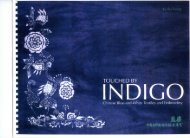Galleries at the ROM - Royal Ontario Museum
Galleries at the ROM - Royal Ontario Museum
Galleries at the ROM - Royal Ontario Museum
You also want an ePaper? Increase the reach of your titles
YUMPU automatically turns print PDFs into web optimized ePapers that Google loves.
LEVEL 3:<br />
The third and fourth floors house <strong>the</strong> <strong>ROM</strong>’s galleries of World Cultures. Drawing from cur<strong>at</strong>orial research by<br />
<strong>the</strong> <strong>ROM</strong>’s department of world cultures on subjects rel<strong>at</strong>ed to West Asia, Egypt, Textiles, Europe, Greece and<br />
Rome, New World Archaeology, and Ethnology as art historians, archaeologists and m<strong>at</strong>erial culture specialists.<br />
The collections range from European arms and armours in <strong>the</strong> Samuel European <strong>Galleries</strong> and <strong>the</strong> cultures of<br />
<strong>the</strong> Middle East, to human and animal mummies from Egypt and <strong>the</strong> ancient pottery, sculptures and coinage of<br />
Greece, Cyprus and <strong>the</strong> Aegean Sea.<br />
<strong>Galleries</strong> of Africa: Egypt<br />
Philosophers’ Walk Building<br />
Djedma<strong>at</strong>esankh Mummy<br />
(cartonnage, moulded<br />
linen, plaster, paint, gold<br />
leaf)<br />
The gallery fe<strong>at</strong>ures approxim<strong>at</strong>ely 1,650 objects from <strong>the</strong> <strong>ROM</strong>'s impressive collection of Egyptian<br />
artifacts, exploring nearly 5,000 years (4000 BC - AD 400) of Egyptian history. Among <strong>the</strong> broad<br />
range of objects on display are agricultural tools from <strong>the</strong> Predynastic Period (4000 - 3100 BC),<br />
everyday e<strong>at</strong>ing utensils, magnificent jewellery, funerary furnishings, pottery, canopic jars, and a<br />
variety of mummies — human and animal. The gallery also includes video kiosks on pyramids and<br />
hieroglyphics, and a rare cast of <strong>the</strong> wall sculptures depicting <strong>the</strong> Voyage to Punt from <strong>the</strong><br />
mortuary temple of Egypt's gre<strong>at</strong> female pharaoh, Queen H<strong>at</strong>shepsut (1503 - 1482 BC). Ancient<br />
Egyptians expressed an extraordinary interest in <strong>the</strong> afterlife, and central to <strong>the</strong>ir religious beliefs<br />
was mummific<strong>at</strong>ion. Seven coffins are displayed in <strong>the</strong> gallery as well as <strong>the</strong> mummy of Antjau, a<br />
wealthy landowner or trader, displayed in an open coffin of plaster and painted wood. Also on<br />
display are papyrus fragments from <strong>the</strong> Book of <strong>the</strong> Dead, a collection of spells buried with<br />
<strong>the</strong> deceased.<br />
A.G. Leventis Found<strong>at</strong>ion Gallery of Ancient Cyprus<br />
Philosophers’ Walk Building<br />
Approxim<strong>at</strong>ely 300 pieces from <strong>the</strong> <strong>ROM</strong>'s extensive collection of Cypriot artifacts<br />
comprise <strong>the</strong> A.G. Leventis Found<strong>at</strong>ion Gallery of Ancient Cyprus. The gallery focuses on<br />
<strong>the</strong> unique art cre<strong>at</strong>ed in Cyprus between <strong>the</strong> Bronze Age and <strong>the</strong> Hellenistic era (2200<br />
- 30 BC). Divided into five sections (Cyprus and Commerce, Ancient Cypriot Pottery<br />
Types, Sculptures, Ancient Cyprus <strong>at</strong> a Glance, and Art & Society: Interpret<strong>at</strong>ions) <strong>the</strong><br />
gallery highlights <strong>the</strong> island's str<strong>at</strong>egic loc<strong>at</strong>ion in <strong>the</strong> Eastern Mediterranean and <strong>the</strong><br />
resulting multiculturalism.<br />
Gallery of <strong>the</strong> Bronze Age Aegean<br />
Philosophers’ Walk Building<br />
A.G. Leventis Found<strong>at</strong>ion<br />
Gallery of Ancient Cyprus<br />
The Gallery of <strong>the</strong> Bronze Age Aegean fe<strong>at</strong>ures over 100 artifacts describing <strong>the</strong> rise and<br />
enigm<strong>at</strong>ic fall of Greek civiliz<strong>at</strong>ions from <strong>the</strong> Cyclades islands, Crete and mainland<br />
Greece, from approxim<strong>at</strong>ely 3000 to 700 BC. The gallery is divided into four periods:<br />
Cycladic (3200 - 2000 BC, centered on <strong>the</strong> Cyclades islands in <strong>the</strong> Aegean Sea, north of<br />
Crete), Minoan (2000 - 1100 BC, named after <strong>the</strong> mythical king Minos by archaeologist<br />
Sir Arthur Evans, flourished on <strong>the</strong> island of Crete), Mycenaean (1600 - 1050 BC,<br />
emerged on mainland Greece), and Geometric (1050 - 700 BC, begins <strong>the</strong> Iron Age in<br />
Greece and a revived Greek civiliz<strong>at</strong>ion focused around <strong>the</strong> city of A<strong>the</strong>ns).<br />
Gallery of <strong>the</strong> Bronze Age Aegean<br />
<strong>Galleries</strong> of <strong>the</strong> <strong>Royal</strong> <strong>Ontario</strong> <strong>Museum</strong> Page 9 of 12<br />
2010

















